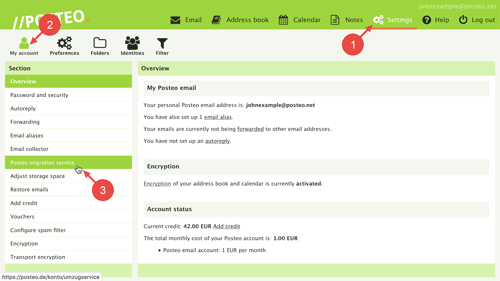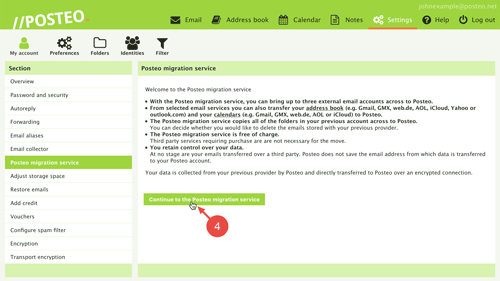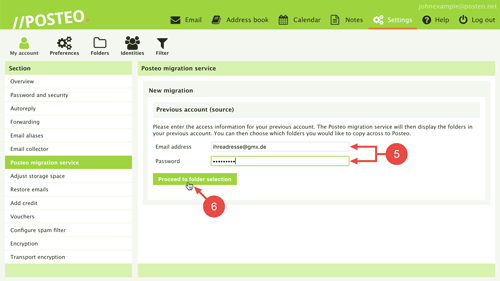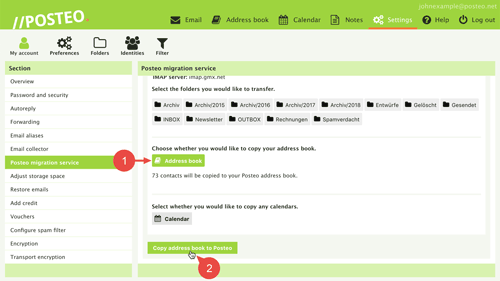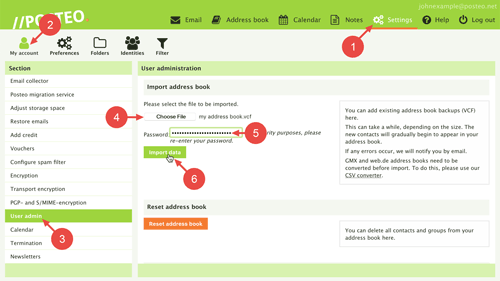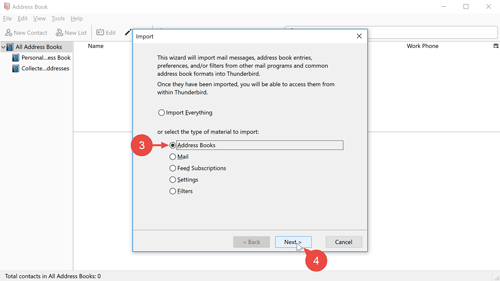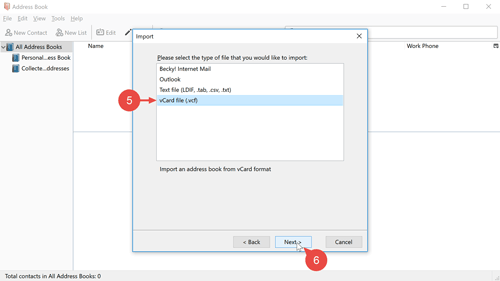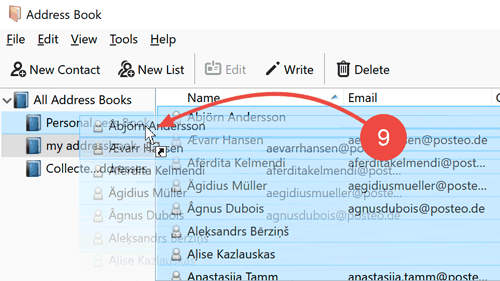With the Posteo migration service, you can conveniently import your address book in addition to your email archive.
This help article explains how to copy your address book across from your previous provider. Automatic migration is possible from selected email services (e.g. GMX, Web.de, iCloud, Outlook/Office365, AOL und Yahoo!).
If you would like to transfer your address book from another provider, please follow our instructions for manually importing address book files.
Posteo migration service: automatic import
To automatically import your address book using the migration service, first log in at posteo.de. Next, proceed as follows:
- Click Settings.
- Click .
- Click Posteo migration service.
- Click Continue to the Posteo migration service.
- Enter the email address (and password) of your previous email account.
- Click on Proceed to folder selection.
Below the list of folders in your previous account, you will find a button titled Address book. To import the address book, proceed as follows:
- Click Address book.
- Click Copy address book to Posteo.
Manually importing address book files
If automatically importing from your previous provider is not possible, you can also import address book files by hand. Address book files are usually .vcf (vCard), .ldif or .csv format. Your contacts are transferred in one of three ways, depending on the file format.
Importing vCards, version 3.0 (.vcf)
Are you not sure which vCard version you have? We explain how to find this out under Which vCard version do I have?
To import an address book with vCard version 3.0, proceed as follows:
- Click Settings.
- Click .
- Click User admin.
- Under Import address book, click Browse to select the address book file from your computer.
- For Password, enter your Posteo password.
- Click Import data to import your address book.
Once Posteo has successfully imported your address book, you will receive a notification. If your address book remains empty despite a success notification, then your address book has an incorrect vCard version. In this case, follow the instructions in the following section.
Importing vCards, version 2.1, .ldif or .csv files
If your previous email provider does not offer vCard export in version 3.0, then importing via Thunderbird is the easiest alternative. The big advantage with this is that Thunderbird automatically synchronises your contacts with Posteo after import.
First, set up your Posteo address book in Thunderbird. If you need help to do this, please refer to our help article How do I synchronise my Posteo and Thunderbird address book using SoGo Connector? Finally, open the address book in Thunderbird and proceed as follows:
- Click Tools (in the menu).
- Click Import.
- Select Address Books.
- Click Next.
- Select the file type in which your exported file is saved on your hard drive.
- Click Next and select the address book file on the computer.
- Complete the import by clicking on OK.
After the import has completed, you can find the address book in Thunderbird.
- Click the imported address book to view the contacts that were imported.
- Select the contacts from the old address book and drag them (using the mouse) to the Posteo address book.
Thunderbird automatically transfers the contacts to Posteo. You can delete the old (imported) address book.
Which vCard version do I have?
When exporting your address book you will usually find a tip about the export format and the vCard version used. If your provider does not state the vCard version, you can find it out from the exported file. To do this, open the exported file in a text editor.
In one of the first few lines of the file, you will see the text VERSION; the number next to the colon is the vCard version.
Tips & troubleshooting
Privacy notice: In this section you will find links to help pages from external sources. It’s possible that they may have active tracking tools, cookies, etc.
Gmail: Migration can only be done manually
Gmail accounts cannot be transferred to Posteo with the migration service. However, this transfer of data can be done manually. You can find a step-by-step guide for your migration from Gmail to Posteo here in the Posteo help section.
Gmx: Enable access via IMAP
Access via IMAP is disabled for many Gmx accounts. If you would like to enable IMAP access for your migration, you can read more about it in the Gmx help section.
iCloud: Create app-specific passwords
A separate password is required for each program with iCloud. You can read about how to create an app-specific password for the Posteo migration service in Apple help.
Web.de: Enable IMAP access
Access via IMAP is disabled for many web.de accounts. You can learn how to enable IMAP access for migration in the Web.de help section (in German).
Yahoo!: Enable IMAP access
Unlike in the past, Yahoo! blocks connections via IMAP by default now. You can enable encrypted access via an IMAP connection with the option allow apps that use less secure sign in. You can learn how to do this in this Yahoo! help article. Please don’t be confused by the wording “allow apps that use less secure sign in”. You are simply enabling normal access via IMAP with this option.

